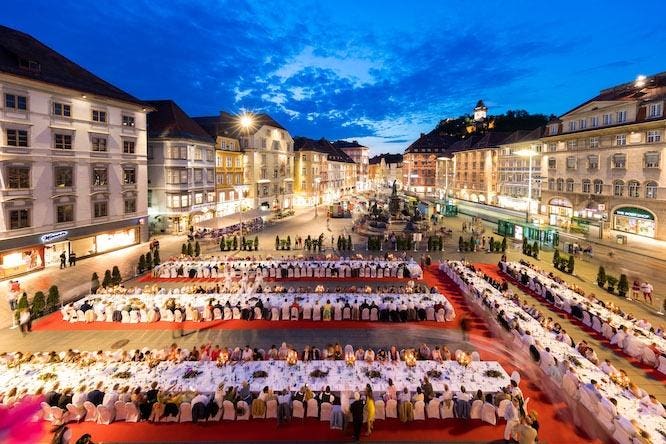Each summer Graz holds its huge outdoor food festival called the Long Table.
As the second-largest city in Austria (after Vienna), you can imagine that Graz’s cultural history is rife with the old and the new in this baroque town of 300,000 people. Dating back to 800 AD, its historic center alone boasts a thousand buildings of interest—fifty percent of them damaged in the war. But today the center city is vibrant, as beautiful as ever and once derelict neighborhoods across the Mur river have been reclaimed and gentrified for the better.
Graz’s indigenous gastro-scene is very diverse, and the locals revel in the bounty of Styrian farms and wineries. There are several walking and bus tours of the city’s breweries, including a progressive pub crawl on Lendplatz. There is an annual truffle festival in fall, and in summer Graz holds its astonishing Long Table celebration at the main square Hauptplatz, where all the trams converge, with dozens of food purveyors, restaurants and breweries serving thousands of people in the open air (next year’s is scheduled for August 8).
The Kunst Haus is devoted to changing exhibits of modern art.
What I found so delightful about eating around Graz is that there is hardly a street or corner where the combination of a cultural site, sculpture garden, food store, bakery or restaurant is not right next to each other, all easily reachable within minutes by those ever-efficient trams. The Halle für Kunst is a contemporary art museum set within a minimalist white structure featuring modern Styrian artists. Even more strikingly modern, the Kuntshaus Graz Museum, which has been variously compared to a huge blue pickle and an extraterrestrial frog, is the city’s unique modern art museum with changing exhibitions.
The Murinsel is a floating island in the Mud river made of still and glass.
It is just steps from the remarkable artificial “floating island” of Murinsel designed by New York architect Vito Acconci in the form of a large steel and glass seashell 47 meters long connected by tunnels on either side of the river. At night both landmarks are gorgeously lighted and shimmer in the rippling river run.
At Der Steirer Austrian Tafelspitz is served in two courses, as a meaty broth and as boiled beef … [+]
Nearby both is one of the city’s most popular restaurants, Der Steirer (Belgiergasse 1; 43-316-703654), is just blocks away. It’s a large, spacious traditional restaurant (though it also serves “Stryian tapas” ) with tall ceiling archways, an excellent wine list and justifiable fame for its fried chicken, a platter of six crisp pieces with a green salad and lemon (€15.90). I thought the Tafelspitz (€29.90) of tender boiled beef preceded by a rich broth teeming with meat and vegetables was one of the best I had in Graz, and its roast pork with wonderful bread dumplings and warm cabbage salad (€19.50) can readily feed two. Only beer, cider and wine is served.
The sea trout called char is a specialty of the day at El Pescador.
Also in the neighborhood is El Pescador (Landhausgasse 6; 43-316-829030), a pleasing diversion from the meat-rich diet of Graz and the city’s best for seafood with a Mediterranean slant. The fish species are the day’s specials, and my wife and thoroughly enjoyed fillet of branzino (€26) and the fine pink lake trout called char (€26), along with a large bowl of tender gnocchi with September truffles (€15).
Landhauskeller has a lovely outdoor courtyard, rich Austrian food and a superb wine list.
And, off a busy shopping street in the Landhaus neighborhood is Landhauskeller Restaurant (Schmiedgasse 9; 43-316-839276), whose large courtyard with wide umbrellas is an enchanting and relaxing place to dine in good weather. The food is hearty—the Wiener Schnitzel (€22.90) is fried in butter—and they have one of the best wine lists for Austrian bottlings in the city.
The Universalmuseum Joanneum is actually a collection of museums, housing the world’s largest historic armory since 1644, with 13,400 small arms and accessories volley guns, mortars, cannons, falconets, and more than 2,000 edged weapons, along with 3,844 items of horse armor. Also well worth a visit here is the Natural History Museum, one of the best maintained, lighted and descriptive in Europe, where such museums tend to be dark and musty. The collection is rich in well-posed, lifelike animal displays relating to geology—the rocks and gems section is unexpectedly fascinating—zoology and botany.
The Eggenberg Palace outside of Graz is a super example of late Renaissance architecture and has a … [+]
Everything worth seeing in Graz is close by and walkable, the only exception being the Schloss Eggenberg just outside of the city and reachable by tram. It is a baroque palace with the curious distinction of having 24 staterooms decorated by Styrian artist Hans Adam Weissenkircher where invited guests of the Eggenberg family could merely walk through for the sole purpose of being amazed by the lavish display. Nothing else went on in those rooms. The banquet hall was elsewhere, as were the family’s living quarters no one ever got to see. There is a 45-minute tour with a guide you can take of all the rooms, though about halfway through the idea behind them becomes more numbing than amazing. Below that floor, however, is a superb museum of the Alte Gallerie of 17th century Dutch masters. Then you may stroll the vast manicured grounds, overseen by a flock of disinterested peacocks.
Bakeries are everywhere in the neighborhoods of Graz’s central city.
All that walking makes a person hungry, but turn any corner in Graz and there will be a pretty bakery, a Wurst store, a café, a wine room, even a sushi bar, if you’re up for it. Graz is very much an international city and a European gem, but its character is truly Styrian, invested with a rich agricultural, vinicultural and brewery traditions that distinguish it from all else in Austria.








